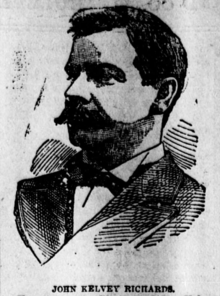John K. Richards
| John Kelvey Richards | |
|---|---|
 | |
| United States Court of Appeals for the Sixth Circuit | |
|
In office February 23, 1903 – March 1, 1909 | |
| Appointed by | Theodore Roosevelt |
| Preceded by | William R. Day |
| Succeeded by | John Wesley Warrington |
| 10th United States Solicitor General | |
|
In office 1897–1903 | |
| Appointed by | William McKinley |
| Preceded by | Holmes Conrad |
| Succeeded by | Henry M. Hoyt |
| 20th Ohio Attorney General | |
|
In office January 11, 1892 – January 13, 1896 | |
| Preceded by | David K. Watson |
| Succeeded by | Frank S. Monnette |
| Member of the Ohio Senate from the 8th district | |
|
In office January 6, 1890 – January 3, 1892 Serving with J. L. Carpenter | |
| Preceded by | William J. Rannells |
| Succeeded by | J. L. Carpenter |
| Personal details | |
| Born |
March 15, 1856 Ironton, Ohio |
| Died |
March 1, 1909 (aged 52) Cincinnati, Ohio |
| Political party | Republican |
| Spouse(s) | Anna Willard Steece |
| Children | three |
| Alma mater |
Swarthmore College Harvard University |
John Kelvey Richards (March 15, 1856 – March 1, 1909) was an Attorney General of Ohio, the tenth Solicitor General of the United States, and later a United States federal judge.
Early life, education, and career
Born in Ironton, Lawrence County, Ohio, Richards was the son of Samuel and Sarah (Kelvey) Richards. Having received his early education in the schools of his native town, he graduated from Swarthmore College with the degree of A.B. in 1875, and two years later received the same degree from Harvard University.
Returning to Ironton, he began the study of law in the office of Judge William Wartenbee Johnson, later Chief Justice of the Supreme Court of Ohio. In 1879 he was admitted to the bar, and in 1880 was elected prosecuting attorney of Lawrence County, serving until 1882. From 1885 to 1889 he was city solicitor of Ironton. In the latter year, he was elected a member of the Ohio State Senate, where on account of his recognized legal ability he was appointed chairman of the Judiciary committee.
Service to the state of Ohio
At the close of his two-year term, he was elected Attorney General of Ohio and reelected for 1894-1896, his term of office being concurrent with those of William McKinley as governor. In 1895, McKinley appointed him member of a commission to codify the insurance laws of the state, and in 1896 he was counsel for a committee authorized by the General Assembly to revise the tax laws of Ohio. In the same year, he was general counsel for the state board of medical registration and examiners and also counsel for the board of appraisers and assessors.
While serving as the Ohio Attorney General, Richards successfully fought through the courts the claim of the state that though it had granted the canal beds to these cities for streets and sewage purposes, the cities had no right to turn them over to the railroads and that the railroads must surrender their use to the state. The tax bills which he as counsel for the legislative committee helped to draft, he was called upon to uphold in state courts and in the United States Supreme Court. His successful defense of these bills, which taxed the franchises of foreign corporations, the property of interstate express companies by the "unit" rule, and the proportionate share of cars of sleeping car companies, gave rise to decisions which became the basis for much important excise and property-tax law.
Federal government service
In 1897, President McKinley appointed Richards to be the ninth Solicitor General of the United States. As solicitor general, he was called upon to handle the difficult legal questions arising out of the Spanish–American War, particularly in reference to the territory acquired by the United States. A number of the Insular Cases were argued by him in the Supreme Court, as were also the Joint Traffic Association and the Addyston Pipe & Steel Company cases. He prepared the briefs and handled the Northern Securities case until his appointment to the bench in 1903.
On February 19, 1903, Richards was nominated by President Theodore Roosevelt to a seat on the United States Court of Appeals for the Sixth Circuit vacated by the elevation of William Rufus Day to the United States Supreme Court. Richards was confirmed by the United States Senate on February 23, 1903, and received his commission the same day, serving thereafter until his death. He sat on the bench for nine years and wrote during that time over 140 opinions, few being over three pages long, and many only one or two.
Personal life
On June 12, 1890, he married Anna Willard Steece of Ironton, Ohio, who with one daughter and two sons survived him.
Sources
| Wikimedia Commons has media related to John K. Richards. |
- John Kelvey Richards at the Biographical Directory of Federal Judges, a public domain publication of the Federal Judicial Center.
 This article incorporates public domain material from websites or documents of the Office of the Solicitor General.
This article incorporates public domain material from websites or documents of the Office of the Solicitor General.
| Legal offices | ||
|---|---|---|
| Preceded by William R. Day |
Judge of the U.S. Court of Appeals for the 6th Circuit 1903–1909 |
Succeeded by John Wesley Warrington |

